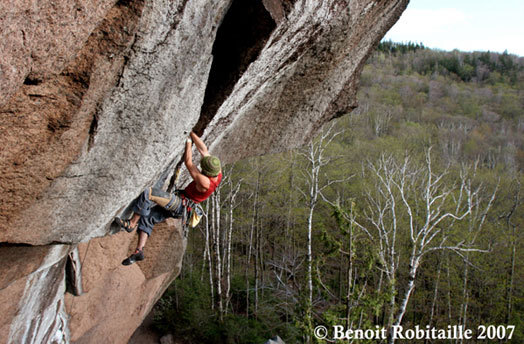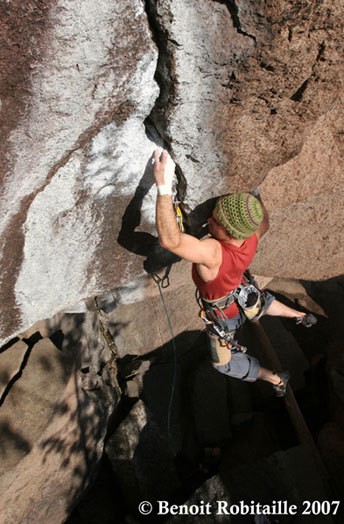
Jean-Pierre Ouellet tackling the first of two roofs on the first redpoint ascent of La Zebree (5.14a), Mt. King, Laurentides, Quebec, Canada. The crack is one of the most difficult in North America; it had been pinkpointed before but never redpointed, as placing (and cleaning) gear on the leaning, overhanging route significantly increases its difficulty. [Photo] Benoit Robitaille
On May 12, after three years of effort, I did the first redpoint ascent of La Zebree (5.14a). This leaning finger crack climbs trough two roofs on the steepest wall of Mt. King in the Laurentides, one hour north of Montreal. The route is considered one of the hardest crack lines in North America.
La Zebree was first climbed in the 1970s and had been attempted by many. In the 1990s Francois Roy came very close to freeing the route, but he could not overcome the crux section of the second roof. He one-hanged the route many times. Jeff Beaulieu, after a couple years of work, pinkpointed the route for its first free ascent. I was really fortunate to be a witness of this ascent (I was belaying him on the send).
I started my Zebree mission in the fall of 2005 when I was returning from a trip out west and was feeling fit. Having seen all the effort and training Jeff had put into this route, I knew the send would be difficult, but I had been looking for this kind of project for a while.
La Zebree is the perfect line, one of the best looking single pitches on the continent, but the climb is rarely in good conditions. It usually seeps badly all spring. It’s not until the end of August that the black flies, hot temperatures and humid conditions subside. A small bit of rain can make the route unclimbable for days. If you’re projecting the route, there is no way around attempting it wet. 2006 was such a rainy year that the route did not have a single day in good conditions, so I began drying out the climb with towels and sponges. Some days it would take me up to five hours to dry the route, and it would not even stay dry for the entire day.

Ouellet working through the second, crux roof of La Zebree (5.14a). It took him two years of work to redpoint the route. He found unusually dry conditions for the send; Ouellet often had to dry the holds with towels and sponges. [Photo] Benoit Robitaille
That same year I started to work on the redpoint, which proved to be much more work than the pinkpoint. La Zebree leans wildly, and its very steep nature makes it impossible to clean in the usual manner. You can’t just rappel and pull out the gear; instead you have to down-aid the route after every try to clean it. So a couple hours of drying the route every day and cleaning the gear after every go kept me from making more than three or four attempts each day. Keeping motivated was not always easy, so I traveled to Indian Creek, Wyoming and Colorado to work on my crack technique. I was able to climb some of the most classic cracks around the US in the process.
This past April I was training at the Red River Gorge when I received a call from my friend Ghislain. He had passed by La Zebree, which appeared to be dry. I sprinted back home to find it had not rained for more than two weeks in Val-David, unusual for spring in Quebec. I still had to dry the route for a couple hours on the first day of work, but after that the crack stayed dry. On the fourth try of the third day, I made it to the anchor.
A couple days after the redpoint I felt strange, and I realized that I would need to find another crack fix.